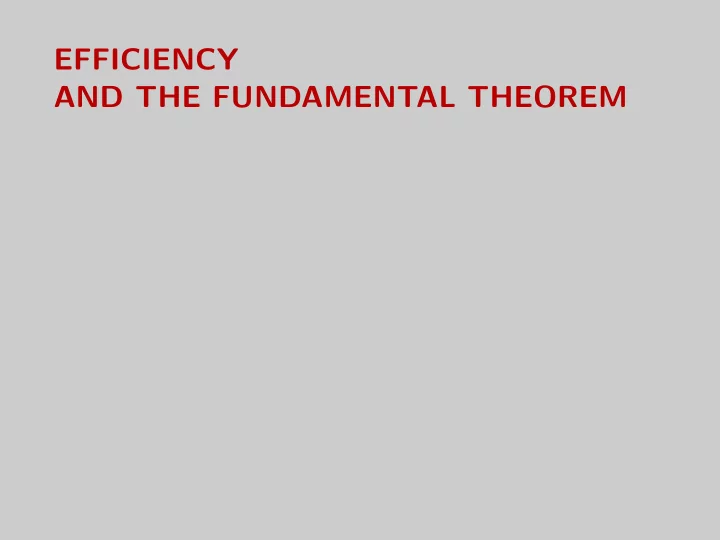

EFFICIENCY AND THE FUNDAMENTAL THEOREM
Gains from trade • In a voluntary transaction, both parties become better off: win-win situation • Much of the value in an economy is created by trade, no necessarily by production
Consumer and producer surplus p p ′ . . . . . . . . . . . . . . . . . . . . . . . . . . . . . . . . . . . . . . . . . . . . . . . . . . D . . . . . . . . . . . . . . . . . . . . . . . . . . q . . . . . . . . . q ′
Consumer and producer surplus p S p ′ . . . . . . . . . . . . . . . . . . . . . . . . . . . . . . . . . . . . . . . . . . . . . . . . . . . . . . . . . . . . . . . . . . . . . . . . . . . . q . . . . . . . . . q ′
Consumer and producer surplus p S p ′ . . . . . . . . . . . . . . . . . . . . . . . . . . . . . . . . . . . . . . . . . . . . . . . . . . D . . . . . . . . . . . . . . . . . . . . . . . . . . q . . . . . . . . . q ′
Consumer and producer surplus p S p ∗ . . . . . . . . . . . . . . . . . . . . . . . . . . . . . . . . . . . . . . . . . . . . . . . . . . D . . . . . . . . . . . . . . . . . . . . . . . . . . q . . . . . . . . . q ∗ Optimal output level
Consumer and producer surplus p S p ∗ . . . . . . . . . . . . . . . . . . . . . . . . . . . . . . . . . . . . . . . . . . . . . . . . . . D . . . . . . . . . . . . . . . . . . . . . . . . . . q . . . . . . . . . q ′ Under production
Consumer and producer surplus p S p ∗ . . . . . . . . . . . . . . . . . . . . . . . . . . . . . . . . . . . . . . . . . . . . . . . . . . D . . . . . . . . . . . . . . . . . . . . . . . . . . q . . . . . . . . . q ′′ Over production
The Fundamental Theorem • Also known as Fundamental Theorem of Welfare Economics • Exchange generates surplus: − Sellers sell for more than marginal cost: producer surplus − Buyers pay less than willingness to pay: consumer surplus • If markets are competitive, then markets are efficient: total gains from trade (surplus) are maximized
The Fundamental Theorem (cont) • Consumers who have a valuation higher than price buy • Producer sells units with marginal cost lower than price • Hence, all trades such that willingness to pay is higher than marginal cost take place • Price indicates whether consumer should buy and whether producer should sell: the invisible hand
The Fundamental Theorem (cont) • A second, less talked about, element of the theorem • Survival of the fittest: only the best firms survive competition • Charles Darwin vs Adam Smith
Allocative and productive efficiency • If q � = q ∗ , then: allocative inefficiency (area C ) • If S � = S L , then: productive inefficiency (area D ) • Market competition minimizes allocative and productive efficiency p p SH A A S p ′ p ′ SL . B . . . . . . . . . C . . B . . . . . . . . . . . . . . . . . . . . . . . . . . . . . . . . . . D . . . . D . D . . . . . . . . . . . . . . . . . . . . . . . . . . . . . . . . . . . . . . . . . . . . . . . . . . . . . q . q . . . . . . . . . . . . . . . . . . . . q ′ q ∗ q ′
The Fundamental Theorem (cont) Critical assumptions underlying competitive markets assumption: • No market power; free entry and exit; level playing field • Well defined property rights (including externalities, IP) • Perfect information
Have you seen the invisible hand?
Recommend
More recommend